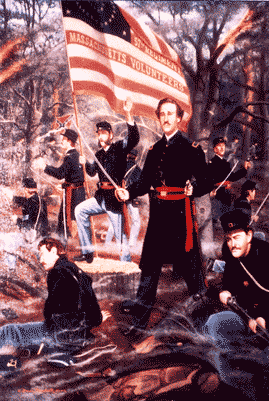| | The
Making of a Medal ...
From Conception to Completion Honoring
the induction of Sgt. Leopold Karpeles into
the Jewish-American Hall of Fame By
Mel Wacks, Director of the Jewish-American Hall of Fame
Courtesy of Coin World While
the web site for the Jewish-American Hall of Fame (www.amuseum.org/jahf) receives
over a million and a half "hits" per year, relatively few people leave
feedback. So, when Leopold Karpeles was suggested in an e-Mail sent on February
28, 2001, Director Mel Wacks was intrigued, since in over 30 years of studying
American Jewish history, he did not recall seeing this name. However, Bob Marcus,
who e-Mailed the nomination, also included a brief history of how Sgt. Karpeles
became an American hero and was awarded the nation's highest tribute - the Medal
of Honor (often mistakenly referred to as the Congressional Medal of Honor). 
Mr.
Marcus, who personally knows the great-granddaughter (Joyce Blackman) of Karpeles,
and who is a Civil War buff himself, also forwarded a photo of a painting "Saving
the Colors" that depicts the Battle of the Wilderness (May 6, 1864), and
in particular shows Sgt. Karpeles carrying the flag of the Massachusetts 57th
Regiment. The painting hangs in the Connecticut Valley Historical Society in Massachusetts.
After additional research, Mr. Wacks decided that Karpeles would be the Jewish-American
Hall of Fame honoree for 2002, and asked award-winning sculptor Alex Shagin to
create the medal. 
Shagin
was shown the painting and a portrait of Karpeles, made many years after his act
of bravery, for reference in creating the obverse design. For the reverse, the
artist was given a reproduction of a letter written by President Lincoln on May
16, 1862, acknowledging the prayers by Congregation Mikveh Israel for the Union
cause. 
Shagin's
first sketch for the obverse was inspired by the painting and Karpeles' own description
of that eventful day: "When ... the right of the 9th Corps commenced breaking
and falling back in considerable disorder, the rebels having commenced a flanking
movement ... (I as) Regimental Color Bearer ... urged (the Lieutenant Colonel)
to stand firm and rally as many of the retreating troops as possible, he said
'All right, I will stand by you.' We then, by every possible exertion, by waving
the colors and otherwise, were enabled to rally a large number of retreating troops
around our Regimental Colors ... thereby saving the portion of the Wing from almost
total destruction, in which engagement our Colors were very severely shattered."
One of the design elements is a tree stump, upon which Karpeles stood to make
the Union colors more visible. 
Even
though the drawing was approved, the artist was not satisfied, and completely
revised it, so that the viewer is drawn intimately into the very dramatic scene.
When the revised sketch was sent to Mr. Marcus, he wrote." It is a very attractive
design. The design depicts him wearing an officer's coat. As color sergeant, he
was an enlisted man and wore a different coat altogether. I would respectfully
suggest this be communicated to the designer/sculptor as the jacket should be
correct and display his proper insignia of rank." 
Shortly
thereafter, Mr. Marcus supplied a sketch "to reflect what Leopold Karpeles
actually wore at the Battle of the Wilderness." Alex Shagin, utilized this
drawing together with other historic materials to create his final design in clay.

(Mel Wacks holding plaster model of obverse)
When
completed, this was cast in Plaster of Paris. Continued
on the Next Page >>
|